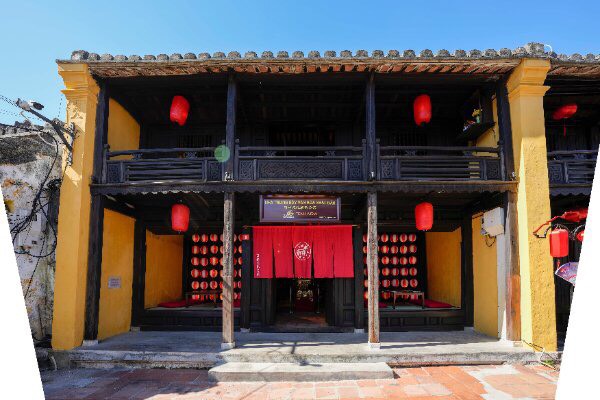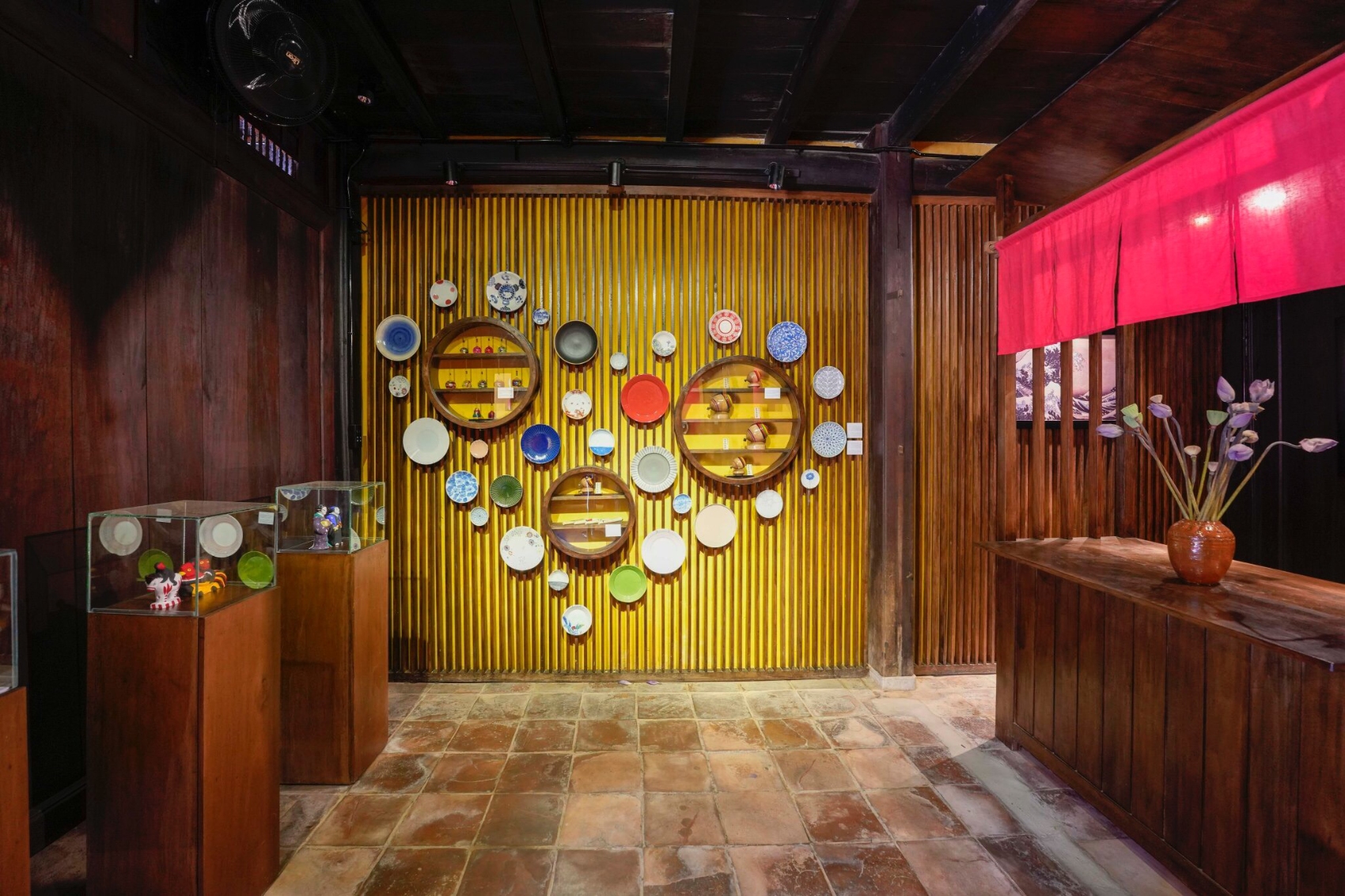Built nearly hundreds of years old, the ancient house bearing tubular architecture is the typical architecture of Hoi An ancient town, which has 2 floors and 3 compartments built in the architectural style. The house is a typical commercial house, processing unique structure with high wooden logs and broad corridors, reflecting the development and fusion of Asian architectural styles in Hoi An in the past centuries. The main frame system is used "hidden pillars, connected rafters" with a fairly simple architecture that not only enhance the artistic value of the house but also make it spacious and ventilated. The house is located at 06 Nguyen Thi Minh Khai street supplies plenty of information about merchant class lifestyle in Hoi An trading port.

After more than two years of preparation, on August 26th, 2022, Japanese Culture Gallery was opened to visitors in celebration of the 18th Hoi An - Japan Cultural Exchange festival. Images and artifacts from the relationship between Hoi An and Japan more than 400 years ago will be on display here, along with pavilions showcasing the history, culture, tourism, and handicrafts of regions that have had long-standing connections with Hoi An, including Nagasaki Prefecture, Sakai city in Osaka Prefecture and Masusaka City in Mie Prefecture, etc. A variety of activities for obtaining knowledge about Japanese culture are frequently organized here, including: a space to practice and enjoy the Japanese Tea Ceremony, Origami paper folding activities, creating weather dolls, drawing Japanese masks, and bookcases filled with Japanese comics. Japanese Culture Gallery contributes to locals and visitors understand more about Japanese culture, as well as the interchange and connections between the two countries' people and the current strategic alliance between Vietnam and Japan.


A palankeen is decorated in the middle of the front house which was given by Mr. Sugi Ryotaro- former special friendship ambassador of Vietnam and Japan. Mr. Sugi Ryotaro was born in 1944 in Kobe, Japan, who is well-known in the Japanese field of art and well-known in the disciplines of music, film, painting, and social activities. He came to Vietnam for the first time in 1989, who loved Viet Nam from the first sight. Until now, he has been associated with Vietnam for more than 30 years in volunteering activities, promoting Vietnam and Japan cultural exchange. He is the adoptive father of 152 Vietnamese children in Berla Children's Village (Hanoi). On the 2nd floor introducing Sugi Ryotaro and his activities with numerous attempts to connect Vietnam and Japan people close-knit together in order to make the deep relationship between two countries.

The first floor is a place to display images of historical documents related to Red-Seal Ships (Shuinsen), Hoi An, Cochinchina and Japan localities. Merchant ships system was developed under the shogunate in 1553, Tokugawa Ieyasu had a policy of establishing international relationships through the development of commercial activities. Merchant ships bearing red-sealed letters patent issued by Tokugawa shogunate were allowed to go abroad for commerce with the purpose of ensuring the safety of Japanese merchant ships and establishing the shogunate's authority. According to the documents of International Studies Institute, Nara Women's University (Japan). From 1600 to 1635, there was more than 350 ships licensed to go to Southeast Asian countries, including 71 ships landed in Hoi An, proving the warm trading relationship between Hoi An and Japanese communities. The famous painting "Diploma of Sea Commercial Trading Port", depicting the journey of a Japanese merchant ship owned by Chaya family, a prominent aristocratic family in Japan who departed from Nagasaki to Hoi An and Cochinchina for trading. The painting depicts in detail the sceneries of Nagasaki and Hoi An with Japanese quarter, Chinese quarter, Lord palace ... are important documents proving the cohesion of culture and commerce in the past. The original of the painting with a length of 4.98m is currently kept at Jomyo Temple in Nagoya Prefecture.

Images and objects about Japanese places with historical and contemporary linkages to Hoi An are on show on the second floor:
- Every seven years, a re-enactment of the wedding of the adopted daughter of Lord Nguyen Phuc Nguyen and Japanese merchant Araki Sotaro takes place in Nagasaki Prefecture's Okunchi Autumn Festival, a traditional festival with a history dating back more than 400 years. The marriage between Princess Ngoc Hoa and businessman Araki Sotaro made numerous contributions to the diplomatic ties between the two nations. The residents of Nagasaki affectionately referred to her as Anio-san. Nagasaki has long been a site of cultural mingling between Japan and several civilizations around the world. The people of Nagasaki are renowned for being hospitable and welcoming, and they are generous with their knowledge of the region's customs, history, and cuisine. Numerous famous Nagasaki delicacies include Shochu wines, Sake wines, Castella cakes, and Champon noodles, etc.

- Pavilion of Masusaka City, Mie Prefecture: This city has a long history of trade in Japan and is home to numerous illustrious trading clans. Masusaka is another city that has historical connections as well as similarities with Hoi An. Visitors will discover about the prosperity of Masusaka's heyday by visiting certain well-liked sights including the "merchant quarter" dating back more than 400 years. Many of the city's well-known goods, including Matsusaka beef and particularly the textile and kimono industries, are well-known throughout Japan. Of these, Matsusaka Momen indigo cloth with vertical stripe weaving technique, which originally originated in Cochinchina of Vietnam, is the most well-known and well-liked. The Matsusaka Moment is distinguished by the method of dying different colors of indigo and weaving vintage blue striped cotton fabrics, becoming a testament to the rich history of Vietnam-Japan cultural exchange.


- In the Middle Ages, the port city of Sakai in Osaka Prefecture was significant for Japan. Not only did it once have a friendly relationship with Hoi An's trading port, but it has also been one of Hoi An's twin cities since the 2000s. GoSokukun, the first mayor of Hoi An's Japanese Quarter, comes from Sakai. His grave, which is still regularly maintained and revered by the residents of Hoi An and his descendants in Japan as a sign of the affinity between the two communities, is situated in Tan An ward. Sakai is home to the Mozu Furuichi tombs- a World Heritage Site, as well as a wooden lighthouse. Sakai is one of Japan's top production hubs for hand-forged knives and metal home appliances. Sakai is a city well known for Japan's long-standing industrial manufacturing industry. Additionally, this area is well-known for its fine handicrafts, particularly incenses, Chusen fabrics, Precision bicycles, etc.









